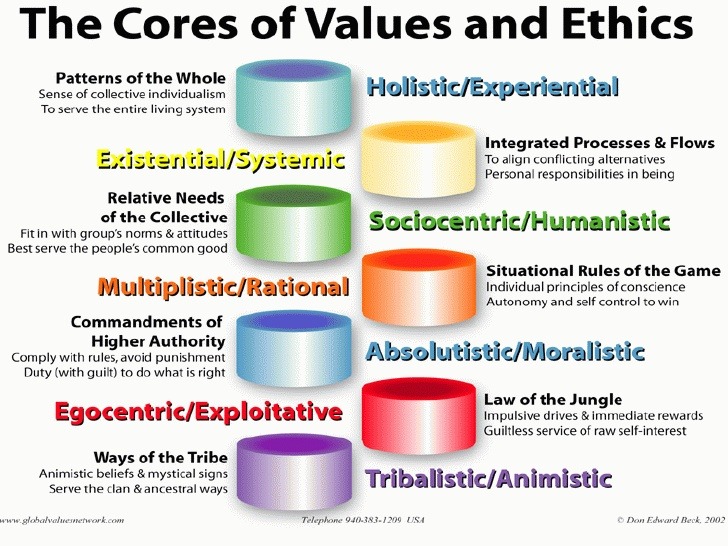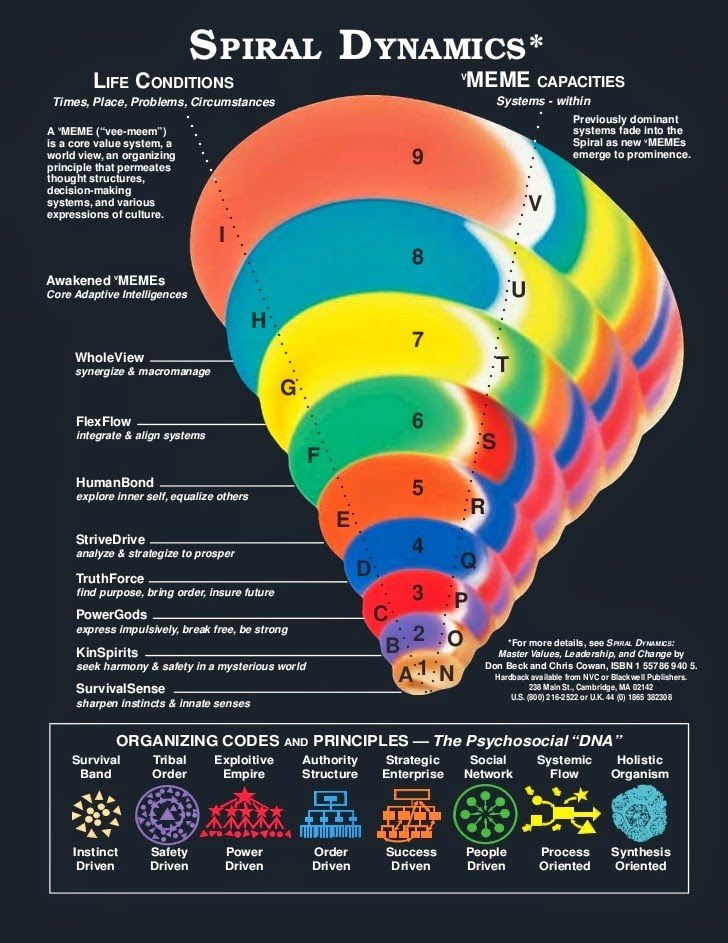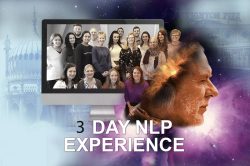An Introduction to Spiral Dynamics and Gravesian Theory
Here is a brief insight to the Values system called spiral dynamics and used in corporations and individuals to gain insight and understanding of human behaviour.
I took my trainers training in Spiral Dynamics (SD) a few years ago, yet it’s still a valuable tool to see and understand my clients and businesses I go into.
Some of the below has been taken from the Spiral Dynamics website www.spiraldynamics.org
People think in different ways. A brother and sister, husband and wife, manager and employee, corporation and client company might have very different world views and values. People in adjoining cubicles or families living right next door to each other sometimes don’t seem to be inhabiting the same neighborhood. Colleagues in an organization have wide ranging ideas about vision, mission, and purpose. Countries sharing one planet often seem to be in totally different worlds with their policies. Why?

Spiral Dynamics is a way of thinking about these complexities of human existence and bringing some order and predictability to the apparent chaos of human affairs. It provides a framework for tracking the evolution of world views and a scaffold on which to stand while analyzing situations and planning the most appropriate actions. Sometimes called levels of psychological existence theory, this work lays out a pattern of human differences and a trajectory for change. It addresses why we have unique perspectives on living, and how our own senses of what “the real world” is like can vary. More than that, SD offers concrete tools for communicating, managing, organizing, and learning to fit who people are and who they are on the road to becoming what they will be next.
Based in the original research and theory building of Dr. Clare W. Graves, this point of view describes how emergent waves of consciousness flow through individuals and groups leading to greater expansiveness in thinking and an increase in conceptual space – the entry of more factors into life’s equation and the ability to incorporate more ways of knowing. It elaborates different ways of behaving which are congruent with shifting views of existence and which people functioning at those different levels deem appropriate. This theory does not track with intelligence per the old IQ models, and only somewhat with intelligences (see Howard Gardner’s work) as they reflect shifting focus of attention. Temperament variables do not fit neatly into this Spiral, either. Although there are some correlations with factors like rigidity, authoritarianism and impulse control, some of these are linear relationships and others appear to rise and fall in different systems.
In other words, this is more of a quantitative than qualitative hierarchy, though both kinds of differences arise among the systems. It describes expansiveness in thinking and conceptualization, not the worth or decency of the person. People don’t get smarter or better as they move through the levels; though they do broaden their perspectives and increase their options to act appropriately in a given situation. They don’t necessarily achieve higher planes of “consciousness” in the neo-spiritual, metaphysical sense, though they do become conscious of more complex factors in more elaborated ways. And they may well come to think about “consciousness” in new and different ways. So the reasons for acting in particular ways change, as do the behaviors. Yet all of this doesn’t necessarily make a person happier or sadder, wiser or more foolish, kinder or harder, better adjusted or more out of sorts; it only increases their degrees of behavioral freedom and opens a different sense of what life is about. (For some remarks by Dr. Graves on the notion that no system is inherently better or worse than another, yet that there is a trend to move along the Spiral to adjust to changes in our human existence, click here.)
Spiral Dynamics® describes biopsychosocial systems along a continuum that form an expanding spiral. (A zig-zag line or a wobbling curve works, too, but a 3-D image is more intriguing.) The term biopsychosocial reflects Graves’ insistence on a multidisciplinary approach to understanding human nature – Bio: for the neurology and chemical energy of life; Psycho: for the familiar psychological dimensions such as temperament, measurable intelligences, and personality variables; Social: for the collective energy in group dynamics and culture as the social atom influences human behavior. These three elements interact constantly within Gravesian levels. Some users also feel it is appropriate to add -Spiritual to make the term bio-pyscho-socio-spiritual systems since they view that as another distinct aspect of human nature rather than being integrated among the others.
This work was called “Value Systems Theory” for a long time. That title produced confusion since most people have a clear definition of values in mind already. When we then add ‘moral’ to values, the field is even more limiting. This model is about where those decisions come from and how they are made. It better addresses why people adopt the values they do, not what those values are. It is deep systems for valuing, not collections of values. Thus, you might think of values, moralities, standards, beliefs, and priorities as contents (memes, per Richard Dawkins et al.). The Gravesian levels in the Spiral Dynamics model are more like containers for them (vMemes – for value system meme attractors). In some ways the container limits its contents, though, just as certain contents require a more specialized container and can’t be force-fit into just anything. The basic eight theoretical containers described in the tables below can hold all sorts of contents. The question is, how do they hold and shape them? How does the person relying on such a container(s) think about the thing? How is that content set shaped by the container it’s put into, and how is the container impacted by the contents? For a more extensive table on Graves and values, click here.
What people in each world seek out in life . . . (Goals of “Successful” Living)

- BEIGE (A-N) survival; biogenic needs satisfaction; reproduction; satisfy instinctive urges; genetic memory
- PURPLE (B-O) placate spirit realm; honor ancestors; protection from harm; family bonds; respect elders; safety for tribe
- RED (C-P) power/action; asserting self to dominate others and nature; control; sensory pleasure; avoid shame
- BLUE (D-Q) stability/order; obedience to earn reward later; meaning; purpose; certainty; Truth; the reason to live and die
- ORANGE (E-R) opportunity/success; competing to achieve; influence; autonomy; mastery of nature; understanding self
- GREEN (F-S) harmony/love; joining together for mutual growth; awareness; belonging; spirituality and consciousness
- YELLOW (G-T) independence/self-worth; fitting a sustainable living system; knowing; the big questions; the long view
- TURQUOISE (H-U) global community without exploitation; understanding of life energies; survival of life on a fragile Earth

Don’t get too bogged down in the jargon and terminology, yet. Focus on the idea of emergent levels of psychological existence – a series of new worlds building upon what comes before and then becoming something unexpected and new. The basic landmarks are designated by colors in the SD language — beige, purple, red, blue, orange, green, yellow, turquoise, coral, and others to come. Those are the “nodal” states – peaks on a series of curves. There are sub-systems between the peaks where the thinking represented by the adjacent colors blend together. (In original Gravesian language, this is done with letter pairs; more on that later.) You could think of them as string of lights. Each light is on its own dimmer. They brighten and fade as conditions change. Sometimes that’s by conscious choice, and often not. For more information on terminology and transitions, click here.
For example, many business people today are in the Orange-to-Green transition seeking a return to more community and spirit in their lives. For some the relativistic, sociocentric Green is brightening as Orange fades; others have shifted back to Blue in an effort to achieve the same sense of purpose and spiritual completion. A number of politicians in developing nations are in the Blue-to-Orange range trying to move their economies from structured, centrally-controlled bureaucracy/theocracy to entrepreneurism and free markets: a fade between bright Blue to more Orange.
Many environmental and activists are living in the Green-to-Yellow zone as they work to achieve positive, sustainable results on a human scale through interaction, involvement, and purposeful learning and teaching. Some parts of the world are still in the Purple-to-Red transition as ancient tribal ways confront well-armed and ruthless dictators. Others are in the Red-to-Blue as centralized authority tries to contain factional ethnic battles and feudal monarchies are challenged by doctrinaire belief sets. Hotspots emerge as corporate interests merged with governmental power – corporatocracies – from the Orange zone overwhelm indigenous peoples in the Purple-Blue range with ideas of progress and development schemes that don’t fit the realities at hand, and which ultimately destroy the less complex cultures, languages, knowledge, and ecology by exploiting them. Yet naive rescuers from the early Green zone sometimes romanticize the primitive and non-functional – a human zoo – thus slowing natural emergence as much as exploiters from Orange zone seek to transform it into their own image, or ‘missionaries’ from Blue structures seek to convert to the -ism of choice. Yellow thinking begins to question and analyze all of these human processes as parts of an integrated spiral where survival of life on earth is at stake, and Turquoise is looking for solutions on a global, holistic scale and lives accordingly. The next zone, Coral, may be the implementer, but that’s in the future.
The cyclical aspect of the Graves/SD theory is depicted with the two color families. The warm color family (beige, red, orange, yellow, etc.) exhibits an express-self way of living with a focus on the external world and how to change and master it (with an internal, I-oriented locus of control); it is how that expressiveness occurs that differentiates the levels. The cool colors (purple, blue, green, turquoise, etc.) have a sacrifice-self way of living with a focus on the inner world and how to stabilize and come to peace with it (with an external, we-oriented locus of control). The Spiral winds between a series of individual “I” and collective “we” poles as it turns between cool, deny-self group systems and warm, individualistic express-self systems. As individuals, most of us are mixtures of both, often living in the transitional phases, and sometimes settling predominantly with one family or the other. This broad swing from individualism to collectivism and back is also something to note as societies move through time and cultures adjust to changes in life conditions.
The SD/Graves model is not a typology for categorizing people into eight rigid boxes. These are ways of thinking about a thing that reside in varying proportions within human beings and which ebb and flow, not labels for kinds of human being. The question is not how to deal with a person at a given level, but how to deal with the thinking of the level when it is activated in its particular way that person. While most of us operate with mixtures and blends of these colors, one or two are often dominant.
The eight levels of existence and the fourteen transitional states between them are only the visible signs of much deeper forces at work. Embedded within the spiral is a double helix. In the spiral diagram above (and below), the alphabet letters on the left represent the Life Conditions – a perception of “what the real world is like” and a particular set of Existential Problems – at each level. Those energies arise from the interaction of two elements: (a) the Life Conditions the person or group encounters and (b) the brain/mind capacities available to cope with such conditions. Thus, the term biopsychosocial suggests a moving blend of the biological nature, the psychology of experience and learning, and the sociology of group interaction with the world. Existential problems (life conditions) trigger neurological capacities (coping systems) and the combination is a level of existence (‘LoE’ in Graves, ‘vMeme’ in SD). This perspective argues that human nature is both nature and nurture — the genetic heritage and biochemsitry interacting with the learning and experiences of being alive. It is this interaction between mind/brain systems inside and existential conditions outside that is central to the Gravesian point of view and energizes of emergence of the Spiral. This also explains why the SD model is an emergent sequence and not a developmental stair step tied to chronology; there is no mandate for movement, and no predictable time-line when there is, only a probably sequence.
The following tables illustrate the colors and letter pairs – AN, BO, CP, DQ, ER, FS, GT, HU, and IV, the last system clearly identified. (Rather than being a continuum of 8+, these systems may also be presented as a series of 6 core themes which repeat. This aspect of Dr. Graves’s hypothesis is as yet unproven, but fascinating to consider and widely promoted. Thus, AN through FS represents a first run-through – a First Tier of thinking systems. Graves called the Subsistence Levels because they focus on relatively basic human needs. The first repeat – Second Tier – is represented by the letters primed; thus A’N’, B’O’, C’P’, etc. These he called the Being Levels because subsistence needs are subsumed beneath quality of existence issues once the problems of the first six levels are in hand. The primes suggest similarities to the base systems, plus an additional set of neuronal capacities brought online. The gap between First Tier and Second Tier appears to be far narrower than sometimes reported, if it exists at all.
The first letter in each pairing represents the existential problems – the life conditions that stimulate a particular kind of thinking to resolve them. The second letter represents the mind/brain capacities – the neurobiological equipment and mindsets required to deal with such a reality. The combinations are represented by the colors which symbolize their interaction, when they are aligned.
The landmark Life Conditions (A, B, C, … I, etc.)
- BEIGE A a state of nature and biological urges/drives; physical senses dictate the state of being
- PURPLE B threatening and full of mysterious powers and spirit beings which must be placated and appeased
- RED C like a jungle where the tough and strong prevail, the weak serve; nature is an adversary to be conquered
- BLUE D controlled by a Higher Power that punishes evil and eventually rewards good works and Righteous living
- ORANGE E full of resources to develop and opportunities to make things better and bring prosperity
- GREEN F the habitat wherein humanity can find love and purposes through affiliation and sharing
- YELLOW G a chaotic organism where change is the norm and uncertainty an acceptable state of being
- TURQUOISE H a delicately balanced system of interlocking forces in jeopardy at humanity’s hands; chaordic?
- CORAL I (too soon to say, but should tend to be I-oriented, controlling, consolidating if the pattern to date holds)
The landmark coping means and neurology activated by such a world (N, O, P, …U, etc.)
- BEIGE N instinctive: as natural instincts and reflexes direct; automatic existence
- PURPLE O animistic: according to tradition and ritual ways of group; tribal; animistic
- RED P egocentric: asserting self for dominance, conquest, and power; exploitive; egocentric
- BLUE Q absolutistic: obediently as higher authority and rules direct; conforming; guilt
- ORANGE E multiplistic: pragmatically to achieve results and get ahead; test options; maneuver
- GREEN S relativistic: respond to human needs; affiliative; situational; consensual; fluid; relativisitc; situational
- YELLOW T systemic: functional; integrative; interdependent; existential; flexible; questioning; accepting; contextual
- TURQUOISE U holistic: compassionate; collective consciousnesses; collaborative energy; interconnected; experiential
Note that the letters are not locked together. They can shift and, to some extent, can be shifted. Thus, it is possible for someone to live in an E level world but only have access to Q means of dealing with life; the world will seem beyond the person’s understanding at times — the old-time government bureaucrat suddenly in a privatized agency that must prove its bottom-line effectiveness. Some things from the more complex level will not ‘register’ in this person’s awareness and coping may be stressful, perhaps impossible. Some people can learn the more complex ways; others are less likely to.
Another person might have T (or N’) capacities, yet work in a situation with a performance appraisal system concentrating on D or E measures; such a person is often underutilized and frustrated by a management system that appears to lag behind the thinking and focuses on issues that seem secondary and narrow — the IT professional working where punctuality and compliance with a dress code matter more than competence or creativity, or the student who is punished for questioning teachers whose approach is far behind the complexity of the thinking. If wise, the organization will adjust its management system to fit the person; the school will match teacher, student, and method. If not, it will lose mind/brain power and interest as the person moves elsewhere. Getting the right person into the right job with the right materials at the right time within the right systems and structures is what SD is about. Then the challenge is to communicate, develop, motivate, and manage those people in ways that fit who they are now and prepare systems for who they will become next.
Some ideas to consider for understanding Spiral Dynamics® –
The Spiral is a framework for how people think about things, not the things they think about. It represents containers that shape worldviews, not the contents that fill them (beliefs, values, etc.).
There is no direct link with intelligence, gender, age, ethnicity, or other demographics except as those variables influence the world around the person.
No level is inherently better or worse than another. They do become more expansive since each builds on all that came before.
The theory is hierarchical in terms of conceptual space (the inclusion of progressively more factors and ways of understanding), but not in terms of intelligence in the conventional sense.
The general trend is up the Spiral because thinking in more complex systems offers more degrees of freedom to act appropriately in a given situation by using more fully the mind/brain which is there.
A person is not generally locked at a single level. The Gravesian systems are ways of thinking about things, not typologies for people, so several can coexist.
Systems are rarely discrete and often run in combinations, though one often will be the dominant state.
Individuals and organizations may appear to be largely of the warm-colored individualistic approach or the cool-colored collective world views.
Gravesian systems do not go away; they are subsumed within more complex layers and can rise to the surface if Life Conditions warrant.
Beware of finding simplicity which is not there. The “emergent, cyclical, double-helix model of adult biopsychosocial systems development” of Dr. Clare W. Graves is more complex than many presenters suggest.
Beware of complications which do not serve the theory. The model is elegant in itself and is sometimes wrapped in details which contribute little of substance and only add confusion.
People may talk about more complex systems without actually operationalizing the ways of thinking and being they describe. Look for “stretch” versions of systems that talk a good game but do not live the worldview.
People may shift their thinking to fit the conditions at hand and operate quite differently when under pressure or stress.
There are entering and exiting phases between systems where most energy lies; the pure colors are only the theoretical peaks of waves.
People value different things because they think in different ways. They think in different ways because the mixes of thinking systems (vMEMEs) in the biopsychosocial complexes in which they exist are different.
Memes and vMemes aren’t the same thing. Memes are the ideas – contents. vMemes are the levels – containers.
Different organizations – companies, schools, NGOs, and governments – occupy different positions on the Spiral and need to develop managerial/governance strategies that match their people, their visions of the future, and the jobs they perform today.
Managers should develop a consistent and systemic approach to all the issues within the organizational loop – recruitment, selection, placement, training, internal management, and external marketing – so they all align, integrate, and synergize.
Organizations should be constructed from both “the top down” and “the bottom up” to link the functions, intelligences, and decision structures that the more complex new problems ahead will demand. Successful organizations are in danger of failing if they continue to manage people in the ways that made them successful in the first place.
Many people need to be managed quite differently today because they have moved on the Spiral even further and faster than most of their bosses, teachers, and even parents. Marketing efforts, strategic plans, and M&A efforts often fail because the designers look into mirrors and assume the audiences and cultures they are attempting to reach share the same values systems they do.
The question is not “how do you motivate people?” but how do you relate what you are doing to their natural motivational flows. A person has a right to be who he or she is. Issues with productivity, quality, political instability, and restructuring are signs of growth and not decay which will force us to find new and innovative ways to manage people based on who they have now become.
Since people learn in different ways form different kinds of teachers, the task of education is to match learners, instructors, learning situations, and technologies designed for fit, function, and flow. Dealing with the whole Spiral at once is the great challenge for everyone, and will be easiest and most natural for those awakening Second Tier thinking (Yellow and beyond).
As a species, the leading edge of Homo sapiens is now at a point of transition between the first six Subsistence Levels and the next series of human existential states, the Being Levels. It is a time of both danger and opportunity as new ways of thinking, indeed, new sorts of human beings, emerge to prominence.
I trust you have found this subject interesting and stimulating. We train Spiral Dynamics on our NLP Master Practitioner course where we use the Values section to understand the whole subject 🙂




